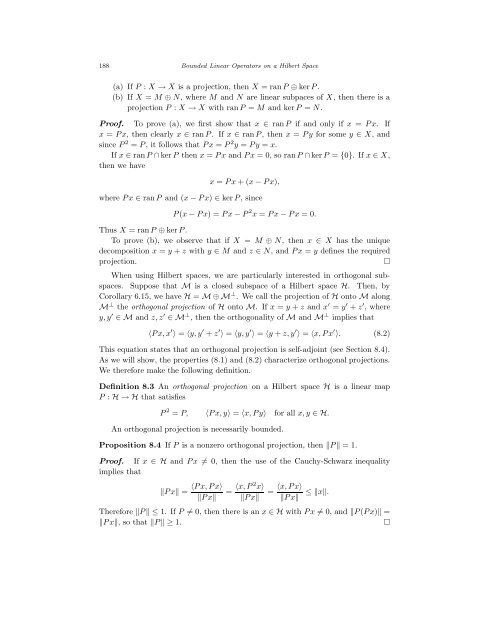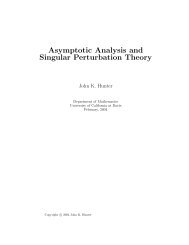Bounded Linear Operators on a Hilbert Space
Bounded Linear Operators on a Hilbert Space
Bounded Linear Operators on a Hilbert Space
Create successful ePaper yourself
Turn your PDF publications into a flip-book with our unique Google optimized e-Paper software.
188 <str<strong>on</strong>g>Bounded</str<strong>on</strong>g> <str<strong>on</strong>g>Linear</str<strong>on</strong>g> <str<strong>on</strong>g>Operators</str<strong>on</strong>g> <strong>on</strong> a <strong>Hilbert</strong> <strong>Space</strong><br />
(a) If P : X → X is a projecti<strong>on</strong>, then X = ran P ⊕ ker P .<br />
(b) If X = M ⊕ N, where M and N are linear subpaces of X, then there is a<br />
projecti<strong>on</strong> P : X → X with ran P = M and ker P = N.<br />
Proof. To prove (a), we first show that x ∈ ran P if and <strong>on</strong>ly if x = P x. If<br />
x = P x, then clearly x ∈ ran P . If x ∈ ran P , then x = P y for some y ∈ X, and<br />
since P 2 = P , it follows that P x = P 2 y = P y = x.<br />
If x ∈ ran P ∩ ker P then x = P x and P x = 0, so ran P ∩ ker P = {0}. If x ∈ X,<br />
then we have<br />
x = P x + (x − P x),<br />
where P x ∈ ran P and (x − P x) ∈ ker P , since<br />
P (x − P x) = P x − P 2 x = P x − P x = 0.<br />
Thus X = ran P ⊕ ker P .<br />
To prove (b), we observe that if X = M ⊕ N, then x ∈ X has the unique<br />
decompositi<strong>on</strong> x = y + z with y ∈ M and z ∈ N, and P x = y defines the required<br />
projecti<strong>on</strong>. <br />
When using <strong>Hilbert</strong> spaces, we are particularly interested in orthog<strong>on</strong>al subspaces.<br />
Suppose that M is a closed subspace of a <strong>Hilbert</strong> space H. Then, by<br />
Corollary 6.15, we have H = M ⊕ M ⊥ . We call the projecti<strong>on</strong> of H <strong>on</strong>to M al<strong>on</strong>g<br />
M ⊥ the orthog<strong>on</strong>al projecti<strong>on</strong> of H <strong>on</strong>to M. If x = y + z and x ′ = y ′ + z ′ , where<br />
y, y ′ ∈ M and z, z ′ ∈ M ⊥ , then the orthog<strong>on</strong>ality of M and M ⊥ implies that<br />
〈P x, x ′ 〉 = 〈y, y ′ + z ′ 〉 = 〈y, y ′ 〉 = 〈y + z, y ′ 〉 = 〈x, P x ′ 〉. (8.2)<br />
This equati<strong>on</strong> states that an orthog<strong>on</strong>al projecti<strong>on</strong> is self-adjoint (see Secti<strong>on</strong> 8.4).<br />
As we will show, the properties (8.1) and (8.2) characterize orthog<strong>on</strong>al projecti<strong>on</strong>s.<br />
We therefore make the following definiti<strong>on</strong>.<br />
Definiti<strong>on</strong> 8.3 An orthog<strong>on</strong>al projecti<strong>on</strong> <strong>on</strong> a <strong>Hilbert</strong> space H is a linear map<br />
P : H → H that satisfies<br />
P 2 = P, 〈P x, y〉 = 〈x, P y〉 for all x, y ∈ H.<br />
An orthog<strong>on</strong>al projecti<strong>on</strong> is necessarily bounded.<br />
Propositi<strong>on</strong> 8.4 If P is a n<strong>on</strong>zero orthog<strong>on</strong>al projecti<strong>on</strong>, then P = 1.<br />
Proof. If x ∈ H and P x = 0, then the use of the Cauchy-Schwarz inequality<br />
implies that<br />
P x =<br />
〈P x, P x〉<br />
P x = 〈x, P 2x〉 〈x, P x〉<br />
= ≤ x.<br />
P x P x<br />
Therefore P ≤ 1. If P = 0, then there is an x ∈ H with P x = 0, and P (P x) =<br />
P x, so that P ≥ 1.
















